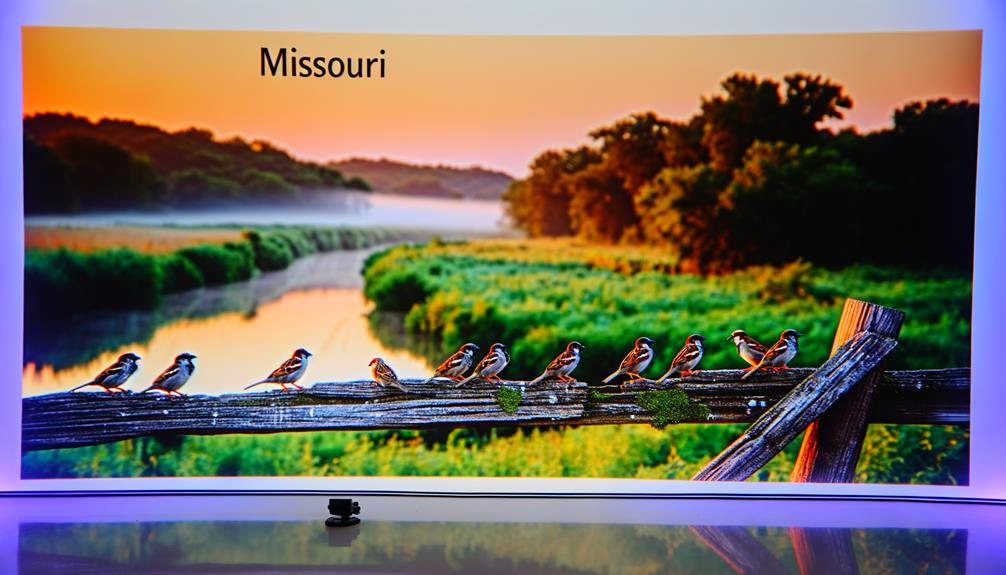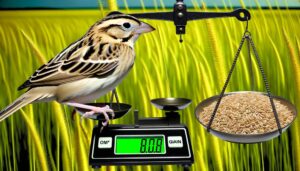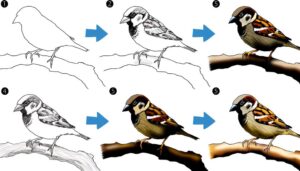5 Common Sparrows to Spot in Missouri
Missouri hosts a range of sparrow species primarily in northern and western grasslands, with fewer in densely forested southern regions. Key characters like the House Sparrow's stout body and gray head, and the Song Sparrow's long tail, help in identification.
Sparrows in Missouri show varied social behaviors and eating habits, mostly consuming seeds and insects. They've adapted well to both rural and urban environments and play key roles in controlling pests and propagating plants.
With further exploration of the topic, one can gain detailed insights on each species and their broad ecological significance.

Key Takeaways
- Sparrows in Missouri include the House Sparrow, Song Sparrow, White-throated Sparrow, Chipping Sparrow, and Eurasian Tree Sparrow.
- These birds can be found in diverse environments like forests, wetlands, suburban areas, cities, and primarily in tallgrass prairies of northern and western Missouri.
- Sparrows in Missouri are social birds, often forming flocks outside breeding season and communicate through distinctive songs and calls.
- Their diet primarily consists of seeds, with occasional insect consumption, playing a significant role in maintaining the state's biodiversity and ecosystem balance.
- To spot sparrows, focus on habitats like grasslands and open woodlands during dawn and dusk, and listen for their distinctive, repetitive songs.
Understanding Sparrows: An Overview
Delving into the world of sparrows, understanding their distinctive characteristics, behaviors, and habitats is essential to fully appreciate the diversity found within this bird species in Missouri.
Sparrows are small, plump, brown-grey birds with short tails and stubby, powerful beaks. They're not just uniform in appearance; their plumage displays a variety of hues and patterns, demonstrating the vast genetic diversity within the species.
Sparrows are primarily seed-eaters, though they won't turn down a juicy insect or two. Behaviorally, they're social birds, often seen in flocks, their communal chirping a familiar sound.
Their habitats are equally diverse, ranging from urban environments to farmlands and grasslands. It's this adaptability that's allowed sparrows to thrive across Missouri.
Sparrows in Missouri: Distribution
Now, let's delve into the distribution of these versatile birds across the diverse landscapes of Missouri. Sparrows aren't evenly spread throughout the state. They're mainly found in regions with abundant food supply and nesting sites, such as the tallgrass prairies of northern and western Missouri.
They're less common in densely wooded areas in the south. Urban and suburban areas host smaller populations, with sparrows often residing in parks, gardens, and other green spaces.
Seasonal changes also impact their distribution. Some species migrate southward in the winter, while others stay year-round.
It's important to mention that habitat loss, mainly due to agricultural expansion and urbanization, poses a growing threat to Missouri's sparrow populations, changing their distribution patterns.
Identifying Missouri's Common Sparrows
To correctly identify the common sparrows in Missouri, it is crucial to pay close attention to key features such as size, plumage color, and the unique patterns and markings on their feathers. These characteristics vary significantly among different species, and can provide valuable clues about a sparrow's identity.
Consider the following table that compares some of the most common Missouri sparrows:
| Species | Distinctive Features |
|---|---|
| House Sparrow | Stout body, gray head, white cheeks |
| Song Sparrow | Long, rounded tail, streaked body |
| White-throated Sparrow | White throat, yellow lores |
Missouri Sparrow Species: Detailed Profiles
Having looked at the distinguishing features of common Missouri sparrows, let's turn our attention to an in-depth analysis of each species, beginning with their habitat preferences, feeding habits, and behavioral attributes.
The Song Sparrow, known for its melodious call, is an omnivorous species, typically consuming seeds, insects, and fruits.
The Chipping Sparrow, on the other hand, mainly feeds on insects during the breeding season, shifting to seeds in the winter. Behaviorally, while Song Sparrows are territorial, Chipping Sparrows often form large flocks.
The White-throated Sparrow displays a unique feeding behavior, scratching the ground in a forward motion.
In contrast, the Eurasian Tree Sparrow, an introduced species, has adapted well to urban areas, often feeding on scraps.
Sparrow Habitats in Missouri
Missouri, with its diverse bird environments, serves as a rich habitat for several species of sparrows. Various nesting locations across the state provide these birds with ideal conditions for reproduction and survival.
Seasonal changes in Missouri greatly impact these habitats, affecting the distribution and behavior of the sparrows.
Missouri's Diverse Bird Environments
Spanning a diverse range of habitats, sparrows in Missouri can be found in everything from dense forests and wetlands to suburban backyards and bustling cities. The state's varied topography creates a mosaic of habitats, each with unique ecological characteristics that influence avian biodiversity.
Dense forests, for instance, provide ample food and shelter, while wetlands foster a rich insect fauna essential for sparrow's diet. Suburban backyards offer bird feeders and nesting sites, and surprisingly, urban areas host sparrows exploiting human-made structures for shelter and scavenging for food.
Missouri's changing seasons further diversify these habitats, with sparrows adapting their behaviors in response. This intricate interplay between sparrows and their environments is a reflection of their remarkable adaptability and resilience.
Nesting Locations in Missouri
Sparrows in Missouri utilize a wide range of nesting locations, from the leafy canopies of dense forests to the cozy nooks of urban structures, demonstrating their adaptability across diverse habitats. They're clever birds, often selecting sites that provide ideal protection from predators and harsh weather conditions.
Here's a deeper look into their nesting preferences:
| Sparrow Species | Preferred Nesting Habitat | Nesting Material |
|---|---|---|
| House Sparrow | Urban buildings, foliage | Grasses, feathers |
| Song Sparrow | Dense shrubs, lower tree branches | Twigs, leaves |
| Field Sparrow | Grassy fields, pastures | Grasses, rootlets |
While each species has a preferred habitat, their nesting choices aren't rigid. They'll adapt, depending on availability of food, safety, and suitable nesting materials. This adaptability is a tribute to the sparrow's resilience in various environments.
Impact of Seasons
Seasonal variations greatly influence the choice of habitats where sparrows choose to dwell, particularly in Missouri. During winter, sparrows favor areas with dense vegetation or human structures for warmth and shelter. Conversely, in the warmer months, they're seen in grasslands and forests, seeking food and nesting locations.
This habitat shift is driven by availability of resources, primarily food and nesting materials.
Spring's arrival sees sparrows building nests in shrubs or trees, using materials like grass and twigs, found abundantly during this season. Fall triggers a food-driven migration to areas with plentiful seeds and insects.
Consequently, seasonality in Missouri dictates sparrow behavior, habitat choice, and ultimately, survival. This cyclical pattern indicates the adaptability of these birds to their ever-changing environment.
Behavior and Diet of Missouri Sparrows
Understanding the behavior and diet of Missouri's sparrows requires an examination of their feeding habits and social interactions.
Feeding habits can reveal not only the species' dietary preferences, but also the essential role they play in the ecosystem.
Equally important to observe are the social interactions which provide insights into mating rituals, territorial disputes, and the overall societal structure of these avian communities.
Sparrow Feeding Habits
In their quest for nourishment, these small birds display fascinating behaviors, often shifting their diet based on the availability of food sources. Missouri sparrows mainly feed on seeds, but their diet can become insectivorous during breeding season, indicating a high degree of adaptability.
Key feeding habits include:
- Seed preference: Sparrows show a marked preference for smaller seeds, which are easier to handle and digest.
- Seasonal diet shift: During breeding season, sparrows change to an insectivorous diet to provide protein for their offspring.
- Food storage: Some sparrow species, like the Fox Sparrow, have been observed to store food for later consumption, demonstrating foresight and resource management.
These feeding habits underscore the sparrow's remarkable ecological flexibility and survival strategy.
Sparrow Social Interactions
While their feeding habits are indeed fascinating, Missouri sparrows also exhibit intriguing social behaviors that further illustrate their adaptability and survival skills.
They're highly social birds, usually forming flocks outside the breeding season. These flocks provide protection from predators, as multiple eyes are better than two. Sparrows communicate through a complex array of chirps and calls, each having distinct meanings.
They're territorial during breeding, males often engaging in fierce fights to secure nesting sites. Notably, sparrows also participate in social grooming, known as 'allopreening', strengthening social bonds and keeping plumage in top condition.
These behaviors, intertwined with their resilient diet, make the Missouri sparrow a masterful survivor in a complex, ever-changing environment.
The Role of Sparrows in Missouri's Ecosystem
Sparrows, these small yet vital components of Missouri's ecosystem, play a significant role in pest control by consuming a wide variety of insects. Their insatiable appetite keeps the insect population in check, mitigating potential damage to Missouri's agriculture and forestry sectors.
These little birds also contribute to seed dispersal, helping in the propagation of several plant species. In turn, this contributes to maintaining Missouri's biodiversity.
To summarize, sparrows in Missouri's ecosystem:
- Serve as natural pest controllers by consuming vast amounts of insects.
- Aid in seed dispersal, promoting plant diversity and health.
- Contribute to the overall biodiversity, maintaining a balanced ecosystem.
Therefore, the seemingly insignificant sparrow is indeed a key player in Missouri's ecological web, showcasing the interconnectedness and delicate balance within nature.
Tips for Spotting Sparrows in Missouri
Birdwatching enthusiasts often find that careful planning and a sharp eye can greatly enhance their chances of spotting the common sparrows in Missouri's diverse landscapes. It's important to understand that sparrows are more active during dawn and dusk, making these times ideal for observation.
Birdwatchers should also focus on habitats where sparrows are known to thrive, such as grasslands, open woodlands, and near human dwellings.
Additionally, recognizing their distinctive songs and calls can aid in successful identification. Sparrows typically produce short, simple, and repetitive songs, which are often the first indication of their presence.
Conclusion
To sum up, Missouri's variety in sparrow species is truly remarkable.
Curiously, the state is home to over 20 different species of sparrows, each playing a crucial role in the ecosystem.
These birds, with their unique songs and behavior, contribute significantly to Missouri's diverse biodiversity.
So, whether you're a birdwatcher or a nature enthusiast, set out on a journey to explore these captivating creatures.
The world of Missouri sparrows awaits, promising a mix of education and entertainment.






